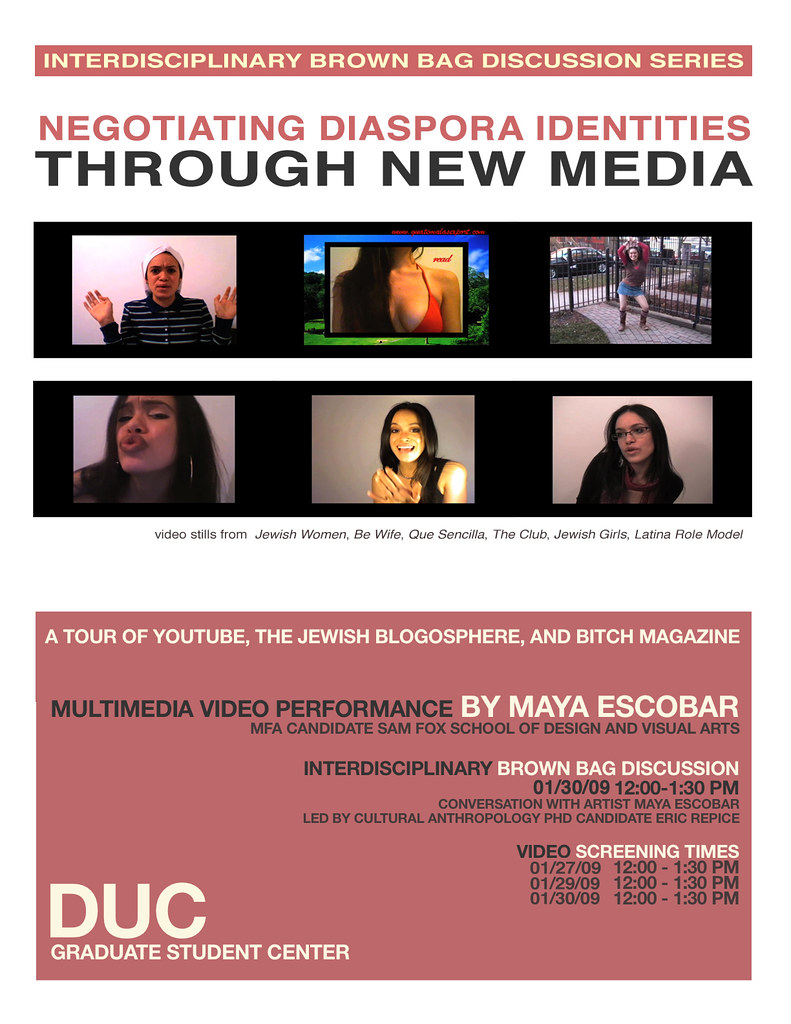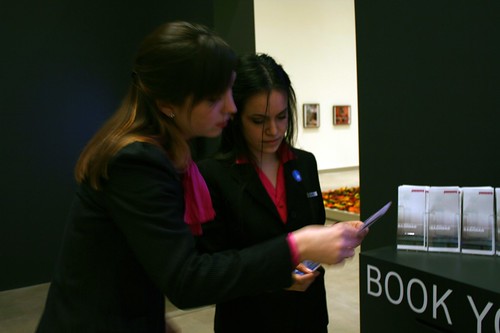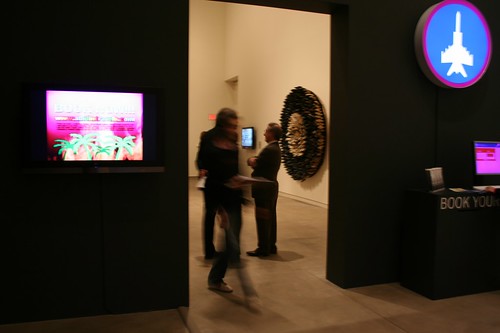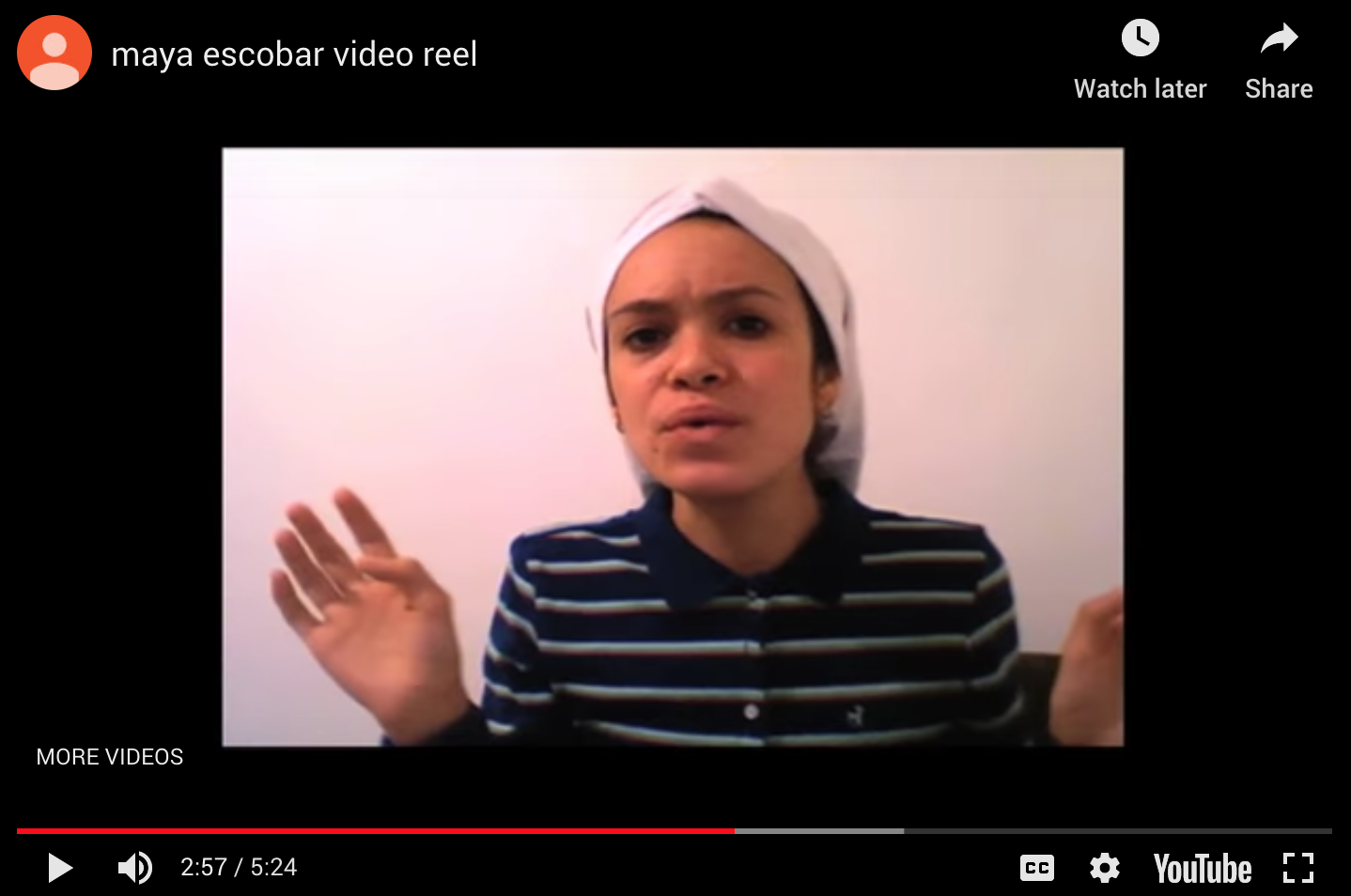Frida on Google.
Artista disléxica del Internet
Por David Sperber en Ma’arav Israeli Arts and Culture MagazineTraducción de Gonzalo Escobar (de Traducción de Shlomit Nehorai)Maya Escobar es sin ninguna duda una de las personas más de moda en el desarrollo del arte judío-estadounidense. Escobar se define como “artista disléxica del Internet”. Y para ver su trabajo uno no necesita ir muy lejos.Su trabajo es creado principalmente en el formato familiar del Internet, y se puede ver más frecuentemente en Youtube. Escobar es hija de madre Judía y de padre Guatemalteco, ella define su trabajo personal y versátil de arte como una investigación antropológica-sociológica dentro de la narrativa que utiliza medios electrónicos contemporáneos.Acciones Plásticas incluye películas de corto metraje que presentan una serie de caracteres persuasivos y monólogos en los que se cuestiona la identidad. En la primera película de corto metraje de la serie aparece, vestida como la artista mexicana Frida Kahlo quien se convirtió en un ícono dentro del discurso feminista. Se argumenta comúnmente que Kahlo tenía algunas raíces judías. Escobar aparece vestida como Kahlo con sus famosas cejas mientras que grita “Yo soy Frida Kahlo. Usted es Frida Kahlo. Nosotros somos Frida Kahlo”. En agitación o en éxtasis se desgarra su ropa, se despeina, se quita el maquillaje y vuelve a ser ella misma.[youtube=http://www.youtube.com/watch?v=xlMPoFXRT18]
En la otra película de corto metraje de la serie, ella continúa con un monólogo de una mujer ortodoxa judía. El texto aquí es tan exacto que por un minuto la línea entre la ironía y la comedia burda y la seriedad profunda es borrosa.[youtube=http://www.youtube.com/watch?v=8H8mpau6dSc]En otra película de corto metraje se presenta el estereotipo de mujer latina como objeto sensual sexual, cuando aquí el tema se desenvuelve también entre la aprobación y la destrucción de los estereotipos. Escobar presenta diversos episodios basados en la realidad que ella misma ha experimentado enfocados en su identidad híbrida como mujer, como judía y como latinoamericana.[youtube=http://www.youtube.com/watch?v=F_1X1igrL4U]Otro trabajo de Escobar es My Shtreimel (Mi sombrero de peluche judío de Europa Oriental) - un vídeo-blog que también se puede encontrar en Youtube. En esta sección aparece un joven de más de veinte años que está sentado frente a una computadora y habla de sus rituales del Shabbat (el día de descanso para los judíos). El monólogo describe un mundo judío amorfo en el cual la esencia judía viva y material no es obligatoria a sus instituciones, sobre todo en el marco personal. Una parte central en este mundo es la auto depreciación de uno mismo: El joven muestra su querido shtreimel y menciona que el shtreimel que se ve como el sombrero tradicional es realmente un sombrero de mujer comprado en una tienda de segunda.
En el trabajo “eruv”* (entremezclarse) Escobar relata el hecho que en Berlín no hay ningún eruv aun cuando allí existe una comunidad judía vibrante. En una serie de entrevistas fotografiadas con los habitantes de la ciudad ella transforma la noción del eruv - en una noción legal halajá (recopilación de las principales leyes judías) que crea una transformación del espacio público en el espacio privado, en una mezcla - la creación múltiple de caracteres y de mundos. El eruv se transforma en un concepto cultural que celebra lo diferente y lo único. Los individuos crean un mosaico espléndido que ensambla un grupo “colectivo” diferente como concepto social. La forma en que Escobar trata el tema es típico al mundo judío-estadounidense del arte que tiende a transferir los conceptos del halajá práctico y para transferirlo a otro mundo, y así se transforma en una metáfora de la condición personal o social. La experiencia personal es significativa a Escobar. Como otros rituales judíos, el Shabbat abarca los sentidos prácticos que materializan la condición privada en un espacio privado. Excepto que el entendimiento del espacio privado y del espacio público es fluido y cambia siempre. Yo pienso que es muy importante de que la gente celebre su Shabbat como experiencia agradable, definida y personal. Los rituales del Shabbat evolucionan con el tiempo - no como obligación inamovible que se transfiere de generación en generación, pero como resultado de una opción simple del individuo de crear él/ella las mismas costumbres agradables de Shabbat. Todos tenemos esta clase de costumbres.”El uso intercontinental del Internet dio a luz a una generación de individuos que crean algo solo por el hecho de crear algo, y el concepto del crear arte por el hecho del crear arte consigue de esa manera un nuevo significado. Los medios de comunicación del Internet conectan a individuos y contribuyen mutuamente a entrelazar a la gente que trabaja por separado en lugares lejanos. El trabajo nuevo del Internet desafía las viejas definiciones en lo referente a lo qué se considera arte y a lo que no es. De igual manera, adopta nuevas formas de la presentación que no son la norma en la corriente principal del mundo del arte, y le revigoriza al campo del arte.La discusión del trabajo de Escobar conduce a una discusión más amplia sobre las diferencias entre el pensamiento judío en la conversación israelita en la nueva comprensión de la opinión estadounidense del mundo. El compromiso judío-artístico en los Estados Unidos está influenciado por la introducción de las ideas de la nueva era en el centro de la conversación, y está integrando en el esfuerzo de crear una conexión entre la cultura contemporánea y la identidad judía tradicional. Dentro de la comunidad estadounidense-judía hay muestras de un movimiento de una expresión judía institucional organizada en una expresión única y personal de experiencias muy personales. Estos artistas que reorganizan las tradiciones en sus propios términos, y de esta manera contribuye no insignificantemente a la definición Ortodoxo-Moderno No-Ortodoxo Judío-Estadounidense nuevamente. El acoplamiento entre la cultura judía y la identidad judía al arte ocupa un papel central en esta conversación.Los ecos de esta tendencia se pueden encontrar también en Israel (por ejemplo, en la cultura joven de Yiddish {idioma hablado por los judíos de Europa Oriental} en Tel Aviv), pero generalmente todavía hay una desconexión profunda entre los conceptos dominantes en Israel y en los Estados Unidos. En Israel es común la conexión entre el judaísmo con una tradición organizada y con el linaje o la línea de sangre y la consanguinidad basada en una continuidad genética. Por otra parte, muchos judío-estadounidenses jóvenes se casan fuera de su religión, pero sin embargo ellos se ven como parte integral del mundo judío y saben que no serán expulsados por esto. En comparación con los israelíes que experimentan su identidad judía en términos de desintegración que siguió la restauración, los judío-estadounidenses crean nuevas ramas donde las metáforas del crecimiento y del renacimiento se acoplan mejor.La unión de la cultura y del arte contemporáneos a la creatividad judía se expresa en características de moda como tatuajes, música hip-hop, arte del Internet y otras formas similares, y se entiende a menudo como la desconexión con la dicotomía dualista aceptada entre lo sagrado y lo mundano. Esto es porqué los tradicionalistas consideran estas formas de arte como provocación peligrosa. La interconexión cultural de estos nuevos conceptos durante discusiones desafiantes con los viejos conceptos culturales. Filológicamente hablando se puede decir que pedir prestados símbolos a partir de una disciplina a otra interfiere con los sistemas semióticos. En el lenguaje Cabalístico (kabbalah o cábala es una de las principales corrientes de la mística judía) se dice que la energía creada durante la fricción producida por la desintegración de las cosas va a crear generalmente “nueva luz”.* De acuerdo a la religión judía durante el Shabbat lo judíos no pueden hacer ningún trabajo, ni tampoco llevar cosas fuera de sus casas o de las murallas de su ciudad. Cuando la ciudad o pueblo no tiene murallas, se tiene que construir un “eruv”, que es una construcción de cables y postes para así poder marcar los límites físicos del pueblo y esto se convierte en una estructura virtual imaginaria.
Frida Kahlo at the synagogue: Maya Escobar
Frida Kahlo at the synagogue: Maya Escobar and the young Jewish-American Creationby David Sperber in Ma'arav Israeli Arts and Culture Magazine.translation by Shlomit NehoraiARTICLE IN SPANISH & HEBREWMaya Escobar is no doubt one of the 'hottest' things developing in the Jewish-American art scene. Escobar defines herself "dyslexic internet artist". And in order to view her work you need not wander far.Her work is mostly created in familiar internet format, and is most often displayed on Youtube. Escobar, daughter to a Jewish mother and Guatemalan father, defines her art work as ongoing personal anthropological-sociological research into the narrative language that uses contemporary media.[youtube=http://www.youtube.com/watch?v=3li_mT--f-A]The "Acciones Plasticas" work includes short films that present a series of convincing characters and monologues that deal with identity questions. In the first short film in the series she appears dressed up as the Mexican artist Frida Kahlo who became an icon within the feminist discourse. it is commonly argued that Kahlo had some Jewish roots. Escobar is dressed and made up as is famously attributed to Kahlo - the uni brow - while screaming "I am Frida Kahlo, you are Frida Kahlo, we are Frida Kahlo". In agitation or in ecstasy she tears her custom, messes up her hair, wipes her make up off of her face and returns to being herself. In another short film in the series she carries on with a monologue of a jewish orthodox woman. The text here is so exact that for a minute the line between irony and slapstick to deep seriousness is blurred. In another short film the stereotypical Latin female as a sexual sensual object is presented, when here too the subject is moving between embracing the stereotypes and breaking them. Escobar is presenting different episodes that she had experienced herself and that deal with her hybrid identity as a woman, as a Jew and as a Latin American.[youtube=http://www.youtube.com/watch?v=NNAxEUEE43Y]
Another work of Escobar is "my shtreimel" - a video-blog that is also presented on Youtube.In that piece appears a young man in his twentieths who sits in his room in front of a computer and talk about his Shabbat rituals. The monologue describes an amorphous jewish world in which jewishness lives and materializes without obligation to its institutions and mostly in personal frameworks. A central part in this world is self deprecation: The young man shows his beloved shtreimel and mentions that the shtreimel which looks like the traditional is actually a women's hat purchased at a thrift store.
In the work "eruv" (intermingling) Escobar relates to the fact that in Berlin there is no eruv even though there exists a vibrant jewish community. In a series of photographed interviews with the city's citizens she transforms the notion eruv - from a halachic-legal notion that creates a conversion of the public space into the private space, into a blending - the creation of a multiple of characters and worlds. The blending (eruv)transforms into a cultural concept that celebrates the different and the unique. The individuals create a splendid mosaic that assembles anew the "collective" as a social concept. The way Escobar deals with the subject is typical to the jewish-american art world that tends to transfer concepts from the practical halachic and transfer them to another world, and so they transform into a metaphor of the personal or social condition. The personal experience is significant to Escobar: " Like other jewish rituals, the Shabbat encompasses practicalities that materialize private condition in a private space. Except that the understanding of the private space and the public space is fluid and changes at all times. I think that it is very important that people celebrate their Shabbat as a pleasant experience, defined and personal. The Shabbat rituals evolve all the time - not as an unbending obligation that is transferred from generation to generation, but as a result of a simple choice of the individual to create to him/herself nice and pleasant Shabbat customs. We all have these kind of customs."The intercontinental use of the Internet gave birth to a generation of individuals who create for creation's sake, and the concept of art for art's sake gets that way a new meaning. The Internet media connects individuals and contributes to mutual influences between people who work separately in far away places. The young work on the Internet challenges the old definitions in relation to what is considered art and what isn't. Similarly, it adopts new presentation forms that are not the norm in the art world's mainstream, and breathes new air into the art field.The discussion into Escobar's work leads into a wider discussion about the differences between the Jewish thinking in the Israeli discourse into the new understanding of the American world view. The Jewish-artistic engagement in the United States is influenced by the introduction of new-age ideas into the center of the conversation, and is integrating into the effort to create a connection between contemporary culture and the traditional Jewish identity. Within the American-Jewish community there are signs of a move from an organized institutional Jewish expression into a unique and personal expression of the very personal experience. These artists reorganizing the traditions on their own terms, and in this way contributing not insignificantly to the definition of Jewish-American Non-Orthodox Modern-orthodox anew. The link between Jewish culture and Jewish identity to art occupies a central role in this conversation.The echoes of this tendency can be seen in Israel as well ( in the young Yiddish culture developing in Tel Aviv, for instance ), but generally there is still a deep disconnect between the dominant concepts in Israel and in the United States. In Israel it is common to connect between Judaism to an organized tradition and to a blood line that is based on a genetic continuity. On the other hand, many young Jewish-Americans marry outside their religion, but nevertheless see themselves as an integral part of the Jewish world and expect to not be expelled from it. As opposed to Israelis who experience their Jewishness in terms of disintegration that followed restoration, the Jewish-Americans create new branches where growth and rebirth metaphors fit them better.The joining of contemporary culture and art to Jewish creativity expresses itself in fashionable characteristics like tattoos, hip-hop music, Internet art and the like, and is often understood as the disconnect with the accepted binary dichotomy between holly and the common. That is why conservative bodies see these art forms as a dangerous provocation. These new cultural concepts interconnect during confrontational discussions with the old cultural concepts. Philologically speaking it can be said that borrowing symbols from one discipline to another interferes with the semiotic systems. In the Kabalistic vernacular it is said that the energy that is released during the friction that is created by the disintegration of the usual vessels - creates "new light".
Negotiating Diaspora Identities Through New Media
 Join PhD Anthropology Candidate Eric Repice and MFA Candidate Maya Escobar in a brown bag lunch discussion concerning transnational, transcultural, and hybrid negotiations of identity through new media.How do these discussions vary between our fields?
Join PhD Anthropology Candidate Eric Repice and MFA Candidate Maya Escobar in a brown bag lunch discussion concerning transnational, transcultural, and hybrid negotiations of identity through new media.How do these discussions vary between our fields? Eric Repicefor more information on Eric Repice visit http://www.artsci.wustl.edu/~esrepice/homefor more information on Maya Escobar visit http://mayaescobar.com[youtube=http://www.youtube.com/watch?v=3li_mT--f-A][youtube=http://www.youtube.com/watch?v=G-GDmDcSH4g][youtube=http://www.youtube.com/watch?v=whLYM9o946w][youtube=http://www.youtube.com/watch?v=Vz2fhmRzCOA][youtube=http://www.youtube.com/watch?v=14bv0-dzMIc][youtube=http://www.youtube.com/watch?v=NNAxEUEE43Y]
Eric Repicefor more information on Eric Repice visit http://www.artsci.wustl.edu/~esrepice/homefor more information on Maya Escobar visit http://mayaescobar.com[youtube=http://www.youtube.com/watch?v=3li_mT--f-A][youtube=http://www.youtube.com/watch?v=G-GDmDcSH4g][youtube=http://www.youtube.com/watch?v=whLYM9o946w][youtube=http://www.youtube.com/watch?v=Vz2fhmRzCOA][youtube=http://www.youtube.com/watch?v=14bv0-dzMIc][youtube=http://www.youtube.com/watch?v=NNAxEUEE43Y]
caminante no hay camino
 There is one specific image that I have never been able to remove from my mind: an image of a Guatemalan solider pointing a gun at the belly of a young pregnant woman. Ironically, I have no recollection as to the source of that specific image. Part of me wonders if that image even existed, or if it was a confabulation of my youth, created in response to the countless stories of political massacre in Guatemala that my father described to me on a regular basis.The Power of ImageRecently I attended a symposium on Architecture, Art and the Experience of Blackness, where I was greatly moved by the words of Hamza Walker, who serves as the Director of Education and Associate Curator for the Renaissance Society at the University of Chicago.In an effort to outline “blackness” or the “black experience”, Walker alluded to the profound impact of the publication of the casket-side Emmett Till photos in JET magazine.The Till incident began with the brutal beating and murder of an 11yr old boy, whose only crime was whistling at a white woman. In a surprisingly high profile trial the two men accused were almost immediately acquitted by an all white jury. The boy’s grieving mother insisted on an open casket funeral so that the world could see what had happened to her beloved son.Walker said, that the media transmission of these transgressions confirmed the collective understanding shared by African Americans that this treatment was the reality of the judicial system. If they were to ever “compromise the integrity of a white woman” what happened to Till would happen to them.Is exposure to explicit images of human brutality the proper way to insure that these incidents do not repeat themselves?How many times have we seen the same iconographic holocaust pictures?But do we know who is in these images and what is taking place?Has seeing the same images a million times done anything the stop the Iraq war or prevent genocide in Darfur?Perhaps the issue comes down to the dissemination of information to young people. Without providing a proper context for the interpretation and dialogue surrounding these explicit images, the depicted incidents become far removed from our lives, and we become numb to their reality.Why a Coloring Book?Coloring Books, emerged in the United States a part of the movement towards the “democratization of education”. They are commonly utilized in popular education models as, accessible teaching tools for often illiterate audiences.This coloring book provides the platform for the introduction and the critical re-evaluation of social movements the context in which they occurred, and the individuals who have preserved and made a major impacts upon the world.
There is one specific image that I have never been able to remove from my mind: an image of a Guatemalan solider pointing a gun at the belly of a young pregnant woman. Ironically, I have no recollection as to the source of that specific image. Part of me wonders if that image even existed, or if it was a confabulation of my youth, created in response to the countless stories of political massacre in Guatemala that my father described to me on a regular basis.The Power of ImageRecently I attended a symposium on Architecture, Art and the Experience of Blackness, where I was greatly moved by the words of Hamza Walker, who serves as the Director of Education and Associate Curator for the Renaissance Society at the University of Chicago.In an effort to outline “blackness” or the “black experience”, Walker alluded to the profound impact of the publication of the casket-side Emmett Till photos in JET magazine.The Till incident began with the brutal beating and murder of an 11yr old boy, whose only crime was whistling at a white woman. In a surprisingly high profile trial the two men accused were almost immediately acquitted by an all white jury. The boy’s grieving mother insisted on an open casket funeral so that the world could see what had happened to her beloved son.Walker said, that the media transmission of these transgressions confirmed the collective understanding shared by African Americans that this treatment was the reality of the judicial system. If they were to ever “compromise the integrity of a white woman” what happened to Till would happen to them.Is exposure to explicit images of human brutality the proper way to insure that these incidents do not repeat themselves?How many times have we seen the same iconographic holocaust pictures?But do we know who is in these images and what is taking place?Has seeing the same images a million times done anything the stop the Iraq war or prevent genocide in Darfur?Perhaps the issue comes down to the dissemination of information to young people. Without providing a proper context for the interpretation and dialogue surrounding these explicit images, the depicted incidents become far removed from our lives, and we become numb to their reality.Why a Coloring Book?Coloring Books, emerged in the United States a part of the movement towards the “democratization of education”. They are commonly utilized in popular education models as, accessible teaching tools for often illiterate audiences.This coloring book provides the platform for the introduction and the critical re-evaluation of social movements the context in which they occurred, and the individuals who have preserved and made a major impacts upon the world.
video reel
[youtube=http://www.youtube.com/watch?v=3li_mT--f-A&hl=en]
abidin travels
 (above)Willie Cole, The Difference between Black and White,2005-6. Shoes, wood, metal, screws, and staples, 85 x 16".
(above)Willie Cole, The Difference between Black and White,2005-6. Shoes, wood, metal, screws, and staples, 85 x 16".
ST. LOUIS, MO - War and disaster have profoundly shaped the opening years of the 21st century. In the United States and abroad, acts of violence and terrorism as well as natural catastrophes have resulted in large-scale destruction and displacement affecting the lives of millions. In February, the Mildred Lane Kemper Art Museum at Washington University in St. Louis will present On the Margins, an exhibition exploring the impact of war and disaster through the work of a diverse range of contemporary artists. Curated by Carmon Colangelo — a nationally known printmaker as well as dean of the university's Sam Fox School of Design & Visual Arts — the exhibition will showcase more than a dozen works, ranging from prints and photographs to video and large-scale installations, by ten artists from around the world. Several installations play against traditional approaches to war memorial. For example, Fallen (2004-ongoing), by the American artist Jane Hammond, comprises a large field of brightly colored leaves, each bearing the name of a soldier killed in Iraq. Similarly elegiac is Metal Jacket (1992/2001), by South Korea's Do-Ho Suh, which consists of 3000 dog tags stitched to the liner of a U.S. military jacket. Abidin Travels: Welcome to Baghdad (2006), an interactive video installation by the Iraqi expatriate Adel Abidin, allows viewers to become virtual tourists amidst the wreckage of his native Baghdad.
In conjunction with the exhibition MFA candidates Carianne Noga, Dan Solberg, Erica Millspaugh and I assumed the role of travel agents assisting museum visitors in arranging their virtual flight Baghdad aboard a B52.


Maya Escobar isn't even Jewish
UPDATE: PHOTOS
 On an almost daily basis, I receive emails from people asking if I am in fact actually Jewish. Although I do find it somewhat bizarre that they find satisfaction in my acknowledgment of what I have already stated numerous times, I usually respond. Come to think of it, the occasions where I have been accepted as a Jew (without further questioning) have been few and far between.
On an almost daily basis, I receive emails from people asking if I am in fact actually Jewish. Although I do find it somewhat bizarre that they find satisfaction in my acknowledgment of what I have already stated numerous times, I usually respond. Come to think of it, the occasions where I have been accepted as a Jew (without further questioning) have been few and far between.
- “ No you can’t be Jewish you are Hispanic”
- “You don’t look Jewish”
- “Escobar… is that a Sephardic name?”
Recently I discovered that without our knowledge, the validity of my own and my brother Gonzalo’s Jewishness has come into question (to the point where documentation has been requested) from people that we are now very close with.Below are some of the examples of comments (not emails, I do not share the content of emails without permission) from youtube:
roundedwhtcollar Am I the only one who thinks this reprobate Turd is NOT in fact a Jew? Rafaelpicc But is her las name jewish? or converted? ReptorY her last name isnt jewish. xruchy you are not jewish i guess... tus videos= cero aporte raquelita40 she's half Jewish/ half Guatemalan.nakedjanet i am also suspicious. for one thing, escobar is not a typical Jewish name. For another, Jewish girls are usually a whole lot smarter, and have a whole lot more substance, than this girl has
(from chaptzem blogspot) There is no way she is Jewish- there may be a small chance her family are anusim or something.But what gets even more bizarre is that interspersed with in those comments are horrible anti-semitic statements:
johnnycastle86xx all the jews have to die, stupid jewish puta de mierda. Que mierda que Hitler no mato a tu familia, asi tu no hubieras nacido. muerte a los judios y muerte a israel. mocrostyle3600 AnotherJewish nasty bitchmrrimfire She's an ugly cockroachfilet there's a nice Jewishcrew- club... Its re-open and called Auschwitz. the drinks are on the house!!! but only for jewish people roshanpinto13 i want to put you in a concentration camp bitch if your people want israel so bad why don’t you go there and rid the world from your hideous jewish ways
So in light of my sarcasric sense of humor I entitled this post : Maya Escobar isn’t even Jewish I wonder what will come of that statement... From Judaism 101: Who Is a Jew?
First, traditional Judaism maintains that a person is a Jew if his mother is a Jew, regardless of who his father is. The liberal movements, on the other hand, consider a person to be Jewish if either of his parents was Jewish and the child was raised Jewish. Thus, if the child of a Jewish father and a Christian mother is raised Jewish, the child is a Jew according to the Reform movement, but not according to the Orthodox movement. On the other hand, if the child of a Christian father and a Jewish mother is not raised Jewish, the child is a Jew according to the Orthodox movement, but not according to the Reform movement! The matter becomes even more complicated, because the status of that children's children also comes into question.
In my case my mother is Jewish and my father is not. Yet it is my father that pushed me to go to Hebrew school until I was 16. Rain or shine my parents have been attending Shabbat services at JRC for almost 20 years. I remember being so mad as a child that my friends got to go out on Friday nights, and I was stuck with my family not even allowed to watch TV when we got home from services. Vickie Korey left the nicest comment on my Rabbi Brant Rosen’s blog:
I remember Maya at Friday night services at JRC, sometimes listening intently, sometimes reading, but always being present. When one of the children of our extended spiritual family grows to be such a fine, thoughtful and accomplished young woman we are all proud. Gonzolo and Tina have worked hard to set a strong foundation for Maya and I am so pleased for her and her family.
A few months ago I met with my Rabbi to discuss my (art) work. During our discussion I mentioned to him how my father is feeling really nervous about me having an orthodox wedding where he will not be included in the ceremony. Brant said something to me that really touched my heart. Your father is the essence of what a Jew is, he is a stranger in a strange land. I agree with him whole-heartedly, and if you ask most JRC members I am sure they would agree as well. However that does not change the fact that he is not considered to be Jewish by our neighbors, and even if he converted, to them it would not be halakhic unless he went through orthodox conversion. So who is a Jew? Who determines this?As I stated in a previous post I will be working as the art director this summer for Camp JRF. I am in the process of creating this summer’s curriculum that will be geared towards answering these very questions and challenging notions of Jewish Identity. Below is a very rough sketch of my plan…. (Please let me know if you have any suggestions, or would be interested in contributing any resources) The Changing Face of Jewish Identity: an exploration of self and what it means to be a Jew in our contemporary societyTo introduce the concept of a changing Jewish Identity will discuss the following:
- How do we define ourselves/ how do others define us?
- Who is a Jew?
- Can someone be more or less Jewish/ who decides this?
- What is our role in society?
- What characteristics make up a Jew?
Mediums Mixed media sculpture Art Exhibitions The Jewish Identity Project Too Jewish Challenging Tradition Identities Written Works by Ilan Stavans Achy Obejas Rebecca Walker Campers will produce mixed media sculptures that reflect their perception of what it means to be a JewPre- Activities:
- We will begin as an ice breaker/ intro to project identifying the characteristics that make up Jews.
- Followed by a discussion on contemporary representations of Jews in Popular culture
Project Campers working in groups of 3-4 will have the option of creating either abstract or representational mixed media sculptures that to them represent Jewish identity. Prior to the construction of their piece students will need to create a (flexible) proposal that outlines their piece.
- Will it be site specific (interact with a certain location)?
- What form will it take?
- Will it have a function?
- What materials will be used based on the above?
If they end up going with more representational sculptures I thought it would be really cool to photograph the sculptures and to place them in various Jewish settings and non-Jewish settings (baseball stadium, temple, Shabbat dinner, work, school....)





